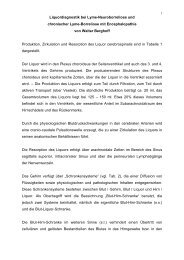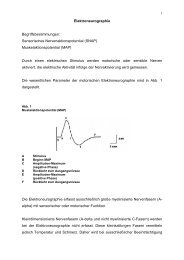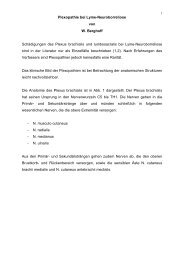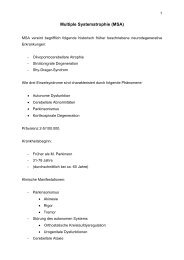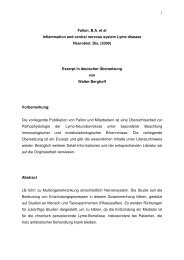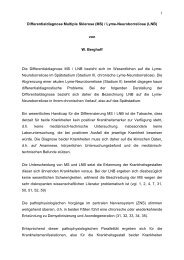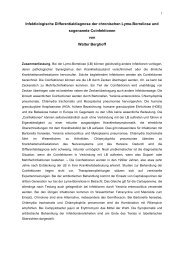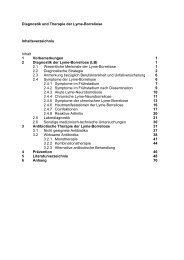Infectiologic differential diagnosis of chronic Lyme disease and so ...
Infectiologic differential diagnosis of chronic Lyme disease and so ...
Infectiologic differential diagnosis of chronic Lyme disease and so ...
You also want an ePaper? Increase the reach of your titles
YUMPU automatically turns print PDFs into web optimized ePapers that Google loves.
Late phase:<br />
- Reactive arthritis<br />
- Erythema nodosum<br />
- Arthralgias<br />
- Ankylosing spondylitis<br />
- Polyarthritis<br />
- Sacroiliitis<br />
- Iridocyclitis<br />
- Abdominal pains<br />
- Diarrhea<br />
- Ulcerative colitis<br />
- Neurological <strong>disease</strong> manifestations<br />
(central, peripheral)<br />
- Nephritis<br />
- Diabetes mellitus (insulin-dependent)<br />
- Hepatitis<br />
- (ANA positive)<br />
- (Rheumatoid factor positive)<br />
- Multisystem <strong>disease</strong><br />
- Reduction <strong>of</strong> the overall survival time<br />
- (thyroiditis)<br />
- Pathogen detection in articular effusion<br />
- Pathogen detection in blood<br />
- Disease progresses in stages <strong>and</strong> intervals with fewer complaints<br />
- Correlation with thyroiditis<br />
- Positive LTT<br />
- Oscillating serological findings<br />
(correlation with <strong>disease</strong> expression)<br />
- (Erythema nodosum)<br />
- (Conjunctivitis)<br />
- (Gastrointestinal complaints)<br />
- (seldom: myocarditis)<br />
Articular manifestations:<br />
- Hip joints<br />
- Knee joints<br />
- Upper ankle joint<br />
- Sacroiliac joints<br />
Yersinia enterocolitica was already recognized as pathogen as early as the<br />
beginning <strong>of</strong> the 20th century. However, the true significance <strong>of</strong> the pathogen, in<br />
particular, under epidemiological aspects was first described in 1995 [146].<br />
Acute illness due to Y. enterocolitica is subject to registration (according to German<br />
law).<br />
The pathogen penetrates into the intestinal wall <strong>and</strong> the mesenteric lymph nodes.<br />
Surface proteins <strong>and</strong> plasmid-bound virulence factors suppress the immune system<br />
<strong>of</strong> the host organism [147-150].<br />
28




